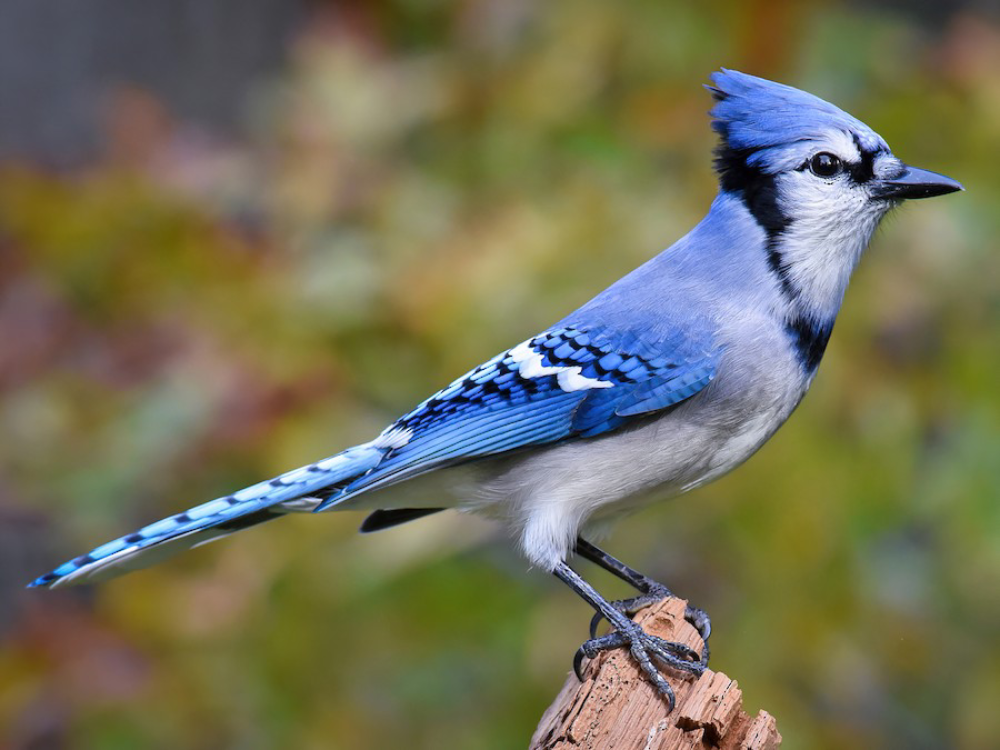Physical Characteristics
Blue Jays are easily recognizable by their vibrant blue feathers, which cover the majority of their body. The blue coloration is not due to pigments but rather the result of light scattering through the bird’s feather structure. It is a phenomenon known as structural coloration. Their wings and tail are adorned with black, white, and various shades of blue, creating a beautiful and intricate pattern. The face is mostly white, with a distinctive black collar around the neck and a black border around the blue crest. This crest can be raised or lowered, depending on the bird’s mood, making it a useful indicator of its emotional state.
Blue Jays are medium-sized birds, measuring about 9 to 12 inches in length, with a wingspan of 13 to 17 inches. They have a robust body, strong bill, and rounded wings. Both sexes appear similar, although males are slightly larger than females.

Habitat and Distribution
Blue Jays are predominantly found in North America, ranging from southern Canada through the eastern and central United States. They inhabit a variety of environments, including deciduous and mixed forests, suburban areas, parks, and gardens. Their adaptability to different habitats has contributed to their widespread presence.
During the winter, some Blue Jays migrate to the southern parts of their range, while others remain in their northern habitats year-round. The migratory behavior of Blue Jays is somewhat unpredictable and varies among populations, making it an interesting subject for further research.
Behavior and Social Structure
Blue Jays are highly social birds, often observed in family groups or small flocks. They are known for their complex social interactions and communication skills. Their vocalizations are diverse, including a variety of calls, songs, and even mimicry of other birds and sounds. The most common call is a loud “jay jay,” which is used to communicate with other jays and to signal alarm.
One of the most intriguing aspects of Blue Jay behavior is their intelligence. They exhibit problem-solving abilities, use tools, and have excellent memory skills. For example, Blue Jays are known to cache food, hiding it in various locations to retrieve later. They can remember the locations of these caches for long periods, even months.
Diet
The Blue Jay’s diet is varied and omnivorous. They consume a wide range of foods, including insects, nuts, seeds, fruits, and small vertebrates. Acorns are a particularly important food source for Blue Jays, and they play a crucial role in oak forest regeneration by dispersing acorns. This mutualistic relationship benefits both the birds and the trees.
In addition to natural food sources, Blue Jays are frequent visitors to bird feeders, where they enjoy peanuts, sunflower seeds, and suet. Their presence at feeders can be both a delight and a challenge for bird enthusiasts, as their aggressive behavior can sometimes drive away smaller birds.
Reproduction
Blue Jays form monogamous pairs that often mate for life. The breeding season typically begins in mid-March and can extend through July. The male and female work together to build a nest, usually in the crotch of a tree or large shrub. The nest is constructed from twigs, grass, and other plant materials, lined with softer substances like moss and feathers.
The female lays 3 to 7 eggs, which she incubates for about 16 to 18 days. During this period, the male provides food for the female. Once the eggs hatch, both parents share the responsibility of feeding and caring for the chicks. The young birds fledge approximately 17 to 21 days after hatching. However, often remain dependent on their parents for some time after leaving the nest.
Predators and Threats
Despite their bold and assertive nature, Blue Jays face several natural predators, including hawks, owls, snakes, and domestic cats. They use their loud calls and mobbing behavior to defend themselves and their nests from potential threats. In addition to predation, Blue Jays are vulnerable to habitat loss, environmental pollution, and diseases such as West Nile virus.
Cultural Significance
The Blue Jay holds a prominent place in various cultures and traditions. In Native American folklore, the Blue Jay is often depicted as a trickster figure, embodying both cleverness and mischief. Its vibrant color and dynamic behavior have also made it a popular symbol in literature and art.
In modern times, the Blue Jay is celebrated as the mascot of the Toronto Blue Jays, a Major League Baseball team, symbolizing strength, agility, and resilience. Birdwatchers and nature enthusiasts continue to be captivated by the Blue Jay’s beauty and intelligence, making it a beloved species in the birdwatching community.
Conservation
While the Blue Jay is currently not considered threatened, conservation efforts are essential to ensure its continued success. Protecting natural habitats, reducing pesticide use, and promoting bird-friendly practices in urban areas can help maintain healthy Blue Jay populations. Additionally, public education and awareness about the importance of biodiversity and ecosystem health play a crucial role in conservation efforts.
Conclusion
The Blue Jay is a fascinating and multifaceted bird, known for its striking appearance, intelligent behavior, and significant ecological role. As we continue to study and appreciate this remarkable species, we gain valuable insights into the intricate web of life that sustains our natural world. So, by fostering a deeper understanding and respect for the Blue Jay, we can contribute to the preservation of biodiversity and the health of our planet’s ecosystems.









